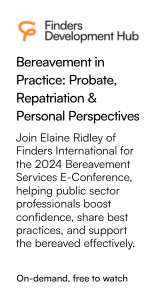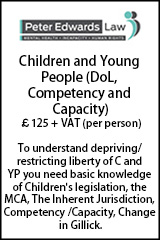Fighting ever increasing odds against a draconian intervention – and when is a without notice hearing acceptable?
- Details
The Court of Protection recently ordered that a woman with late onset vascular dementia be transferred to a residential care home after relations between her son and care workers broke down. Alex Ruck Keene analyses the ruling.
In Hull City Council v A & Ors [2021] EWCOP 60, Poole J was concerned with – in effect – what was less bad: allowing a woman with dementia to remain at home in the care of a son about whom there were significant concerns, or authorising steps to remove her, even if temporarily, to enable assessment of her health and wellbeing. The case concerned a 76-year-old woman, Mrs A, living her in her own home. She was a widow with four living sons, one of whom, B, lived with her.
When the local authority with responsibility for her initially approached the Court of Protection, contending that it was in her best interests to be transferred to a residential care home, it was initially rebuffed, it appears in large part on the basis of her consistent wish to remain at home, the court instead approving B’s proposal that should be her primary carer at home, and assuring the court that he would seek professional support as needed.
This position held for several months. However, consideration of whether Mrs A should be vaccinated against COVID-19 triggered a significant change in B’s approach to engagement with carers, professionals and the court. He unilaterally and immediately cancelled all care and support for her within the home and he stopped his mother visiting the day centre. He stopped visitors coming into the house. He had become increasingly hostile to visits from social workers such that no professional was permitted by him to cross the threshold of Mrs A’s home for at least a month. He had become abusive and agitated when social workers attempted to visit Mrs A, shouting at them from an upstairs window, threatening to call the police, and ordering them to leave. B also refused to meet with social workers outside the house. B’s decisions also made it impossible for other members of the family to visit Mrs A at home.
The local authority’s concerns were also heightened by evidence (not previously known to the court) showing that B had a long history of criminal activity including multiple convictions related to cannabis, including supply. He had multiple convictions for assault. Most seriously, he had received a ten year sentence of imprisonment in late 1994 for an offence of causing grievous bodily harm with intent. His most recent offence was for battery in 2010. In light of this, and its escalating concerns as to Mrs A’s welfare, it came to court to seek orders bringing about her transfer to a care home – which was not at that point immediately available but would be so within a matter of weeks.
When the matter first came before Poole J it did so on a without notice to B, as he explained at paragraph 21:
The reason for applying without notice was the perceived danger that he would react to notice by putting A at risk of harm. That is not an unreasonable supposition given his recent behaviour, but the court should only proceed in exceptional circumstances to make orders of the kind sought without notice to those affected. Given B’s history and conduct, given his stated rejection of the authority and his frank disengagement from the court process, it was my judgment on 29 October 2021 that it was likely that he would take steps to frustrate the order of the court if notice were given to him. Giving notice to B would increase the risk of harm to A. Balancing his Art 6 rights with his, and A’s, Art 8 rights, the risk of B acting in a way that would be harmful to A if notice were given, and the risk that he would take action to frustrate the court’s orders, I was satisfied the exceptional course of proceeding without notice to B was justified.
At that point, however, Poole J was not satisfied that the matters had yet reached the point where immediate intervention, with the authorisation of restraint if necessary, was imperative. As an intermediate step, he made orders in Mrs A’s best interests that B should allow a health and welfare check to be conducted at his mother’s home for up to one hour on reasonable notice without B present in the same room, and that he was prohibited from obstructing or interfering with that meeting. A penal notice was attached to the injunctive orders made. Poole J adjourned the without application to removal and gave permission to the local authority not to inform B of the fact of the application. Poole J listed a closed and then an open hearing for the day after it was intended that the order requiring B to grant access to be served.
The order was served by social workers on behalf of the local authority, but did not produce the desired effect. B did, however, attend the open hearing, at least for part of it.
33. He told the court that A is well and that he ensures that she takes her daily medication. He told me that she was less paranoid and so was improving. Indeed, A has appeared well when seen briefly by others at the threshold to her home. He told me that he wants a second opinion on A’s mental capacity, indicating that he does not accept that she lacks capacity to make decisions about her residence and care. The evidence from Dr Adebayo was, however, very clear and relatively recent. He is opposed to any visitors (including presumably someone who was instructed to assess capacity) entering the house because of the risk that they might spread the Covid-19 virus to him and A. He expressed the view that it was nobody else’s business how he and A lived and that she was not isolated because he is with her 24 hours a day. I asked what protective measures could be taken by way of negative testing for Covid-19, mask wearing or otherwise for him to allow visitors into the home to see A for themselves in a proper manner. He became more agitated. He did not answer the question but referred to “things I have seen”. I asked him the question again and he left the hearing.
It appeared that B might have left the hearing because of an internet problem, but he declined to rejoin. Poole J reached the view that:
36. From his participation at the hearing today and what he told Ms Bradley as reported to me, as well as all the previous evidence in the case that was before me on 29 October 2021, I conclude that B has become implacably antagonistic to the Local Authority, social workers, the Court, and the legal representatives for A. His avowed reason for not allowing visitors into the house appears to be a fig leaf – his real reason is distrust of all those involved in this case, apparently initially triggered by consideration of A being vaccinated, not protection from Covid-19. If, as he says, he would allow an independent person to enter the house, that shows that his objection to social workers from the Local Authority entering is not due to the risk of Covid-19 transmission.
Poole J therefore had to grasp the nettle of what to do:
39. Firstly, I revisit the question of proceeding without notice to B. Although he knows that the court made orders on 29 October 2021 without notice to him, he still does not have notice of the application to remove A from the home and to convey her to Y. That application has continued to be heard in closed proceedings. I am satisfied following the hearing on 2 November 2021 that if he were to have notice there would be a substantial risk that he would use the time afforded to him to obstruct A’s planned removal and conveyance. He would be likely to take steps to frustrate the purpose of the order. Those steps could put A at risk of harm. I am satisfied that the exceptional course of proceeding without notice to him is required in this case.
40. As to the substantive question of whether it is necessary now to take steps to remove A from B’s care and to accommodate her at Y, I have to weigh all the circumstances when determining A’s best interests, following the statutory provisions set out above. I have already referred to A’s wishes and feelings and the views of others about her best interests. They have not changed since 29 October 2021. It is however now clear to me in the light of events since 29 October 2021, that it cannot be in A’s interests to continue to be looked after by her son, given his current state of mind and his history, with no means of checking adequately on her safety, health and welfare, or her use of medication. It is also necessary to seek to ascertain her wishes and feelings which is not possible so long as B controls her contact with others in the way he has done. It is possible that B is keeping A safe and well. But it is also possible that his relationship with her and care for her is harmful to her. The court cannot know, because he has obstructed all reasonable attempts to check on A and for her Litigation Friend and legal representatives to be able to assess her wishes and feelings and interests.
41. It would not now be realistic to force entry to carry out checks on A with a view to her remaining in the home immediately afterwards. The circumstances would not be conducive to an effective assessment of her health and welfare within the home in the immediate aftermath of removing B for the purpose of checks being carried out. After assessment there would be no carers available to provide her with care within her own home. The earliest that carers might be available to provide 24 hour care in the home is 12 November and that is subject to risk assessments. In any event B has shown himself unwilling to allow any carers to have entry to the home, so he would have to be kept out of the home. Previously he has stayed next door to A’s home. He could do so again and cause difficulties for A’s care in her own home. The alternative of allowing B to continue to care for A in her own home after an assessment would be fraught with risk. He would be likely to be in a very agitated state. He might well be even more likely to take steps to obstruct future access to A. The health and welfare check might confirm that A is safe and well, but it might equally reveal that she has not been well looked after by B, has come to harm, and ought to be protected from him. B’s conduct on 1 November 2021 and his appearance at the hearing today have confirmed that attempting to remove B from the house in order to assess A and then to leave her in the home afterwards to be cared for by B is not now a realistic option.
42. B has been given every opportunity to work with others and the court. He stubbornly refuses to do so. The only viable option that remains for checking on A’s health and welfare is to remove her from her home for an interim period to be cared for at the Y residential care home.
43. The alternative is to leave A in the care of B in her own home. I have already referred to the risks of so doing. In addition I have to take into account the risk that the process of removing A and transferring her to the care home could well be harmful to her.
Poole J was clearly troubled by the position:
The situation is precarious and every option is laden with risk. The decision, balancing all the competing factors, is a difficult one, but it has to be made. My concern in leaving A in the sole care of B with his history of violence and drug use, his easily triggered agitation, his hostility to social workers and other visitors to the house, his intransigent determination to isolate A and to be the only one who has contact with her, his obstruction of attempts to assess her health and wellbeing, mean that the removal of her from the home for a short period is now necessary in her best interests. Taking into account all the matters which the court must balance when considering A’s best interests, I am sure that it is now in her best interests to be moved from her home to the Y residential care home for an interim period. I shall list the case before me for a review hearing approximately one week after A’s transfer to the Y care home which will now take place on 3 November 2021. I shall authorise the use of restraint to ensure that A is safely conveyed to the care home, in accordance with the measures set out in the Transition plan. I shall make injunctive orders against B to seek to ensure that the transfer is carried out as peaceably and safely as possible. I shall make provision for A to have contact with B and other family members in safe circumstances, in her best interests once she is at the care home.
In an addendum to the judgment (rare in welfare judgments, even if relatively common in medical treatment cases), Poole J recorded that Ms A was safely transferred to the care home without the need for physical intervention or restraint.
Comment
Having just had the chance to have a first look at Beverley Clough’s new, and very stimulating, work The Spaces of Mental Capacity Law: Beyond the Binaries (review forthcoming when I have a moment), what came to my mind when reading this judgment was how to hold a (not literal – thankfully) inquest into what other possible courses of action, and by whom, could have led away from the point where Poole J found that he was constrained to require Mrs A’s – temporary – removal from her own home. I would suggest that this would be a very useful exercise for any wanting to think – for instance – about the application of Articles 16 and 19 CRPD (the duty upon States to protect those with disabilities from violence and abuse and to secure their right to independent living respectively).
Into that ‘inquest’ would go the fact that – as happens more often than might appear from reported cases – the court was seeking in the face of considerable odds to secure Mrs A’s continued residence at home. Those odds do, from the judgment, appear to have become increasingly insurmountable in light of the position adopted by B – but, notwithstanding the tantalising addendum, it would be fascinating (and important) to understand whether Poole J’s clear intention that the transfer to the care home be on an interim basis ultimately leads to a permanent situation, or whether a solution enabling her return home can be crafted and/or tolerated by the local authority and the court. It will equally be fascinating, and important, to identify insofar as possible what Mrs A wants as part of that exercise.
Alex Ruck Keene is a barrister at 39 Essex Chambers. This article first appeared on his Mental Capacity Law and Policy blog.














































